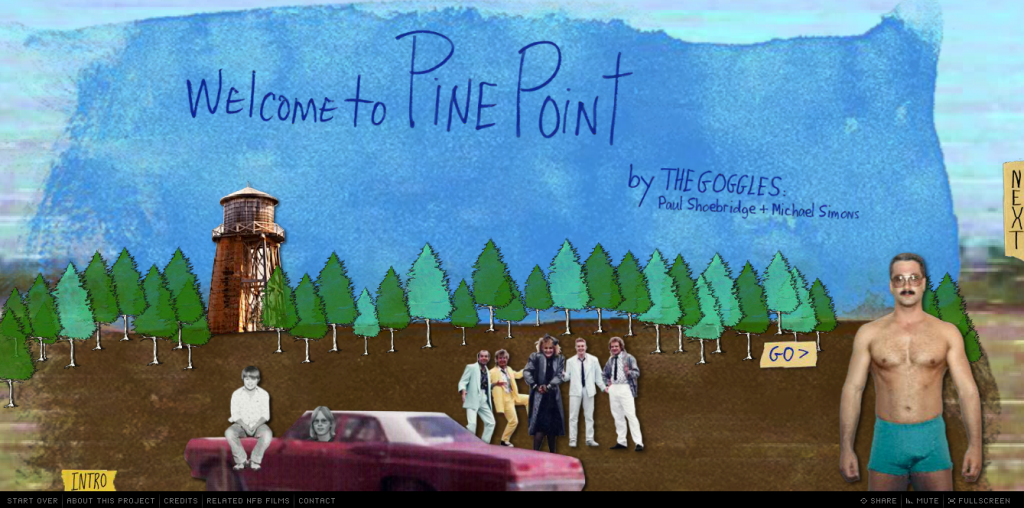In various discussions about their interactive documentary, Welcome to Pine Point, the Goggles (creative team of Michael Simons and Paul Shoebridge) emphasize the importance of linear (as in, beginning, middle, end) storytelling. In an interview with Nieman Storyboard they argue:
The thing for us that we’re happiest with is that we stuck to what linear “narrative” has done for so long: that beginning, middle and end. Because we stuck with that, that’s the thing that worked the best for us. People want to be told stories, they want to be engaged.
When people think of digital interactive media, one of the first things they say is “It’s going to have multiple entry points, and you can go wherever you want to.” And sure, you can deliver certain kinds of information like that, but it’s not super-great for stories, at least in our experience. You can skip ahead, if you want to, you can go four chapters ahead, but you can also do that with a book.
We’re hoping that we’re keeping people engaged and keeping each section as interesting as possible. For us, I think that was the key. We had to break it into chunks, because that’s how it had to go. We wanted people to be engaged, so using media like writing meant that you have to read it to experience it. You could flip through it and kind of experience it, but if you don’t read it, you’re not really getting engaged.
The Goggles
And in their manifesto, they explain:
Sure, in Pine Point you can skip ahead, in the same way you can fast forward a movie or skip to the end of a book, but there are dozens of little things that we employed to keep you moving forward, one spread at a time. The simple Previous and Next buttons, for instance, give some reassurance that there’s no other path, no up or down, or diagonal. The content that does allow you to drill down is contextualized in the page – a pile of photos, a series of videos, with reassuring numbers and controls.
The Goggles
The Goggles believe that a linear story, with a clear path from beginning to middle to end, compels the user, inspiring them to come along on the narrative journey. The Goggles see the role of the storyteller as the tour guide that leads you through the story, pointing out interesting things along the way.
As a user experiencing Pine Point, I must admit that the linear aspect of the narrative was my least favorite part of the experience. I can appreciate that a clear path might give some users “reassurance” or comfort that they are reading/watching it the “right” way or that their storytelling guide is trustworthy. But, I felt that it restricted my ability to explore and be curious about Pine Point and all of the stories/documents/photos. And I’m not so sure that being reassured that we are reading the story the right way or that we can uncritically trust our storytelling guide should always be the goal. Their model seems to reinforce the idea of a Storyteller who tells a story to a passive/listening audience who sits back and is dazzled and entranced by the storyteller’s tales. Do users have an opportunity to participate in the process?
Additionally, I’m struck by the Goggles limited reading of storytelling as always being linear and working best with a beginning, middle and end. I’m reminded of Ursula K. LeGuin’s wonderful essay, What Makes a Story. In it she writes:
A story has a beginning, a middle, and an end:” This comes from Aristotle, and it splendidly describes a great many stories from the European narrative tradition, but it doesn’t describe all stories. It’s a recipe for steak, it’s not a recipe for tamales. The three-part division is typically European, and I would say that it’s also typically European in putting emphasis on the end — on where the story goes, what you get to.
Ursula LeGuin
Yes! I like this idea that linear stories are useful and valuable, but they aren’t the only way to tell a “good” (as in compelling, effective, engaging, entertaining, inspiring, interesting, provocative, educational) story. What other story forms can we draw on when working on interactive documentaries?
In her essay, LeGuin wonders about shifting away from storytelling time (especially progression of time: begin here, end here) and towards storytelling space. She imagines the story as a house, with different rooms to explore and windows to look out of, onto imaginary landscapes. I want to think more about the story as a house; it’s a powerful metaphor that seems fitting to use in my stories about the Farm as a home space.
